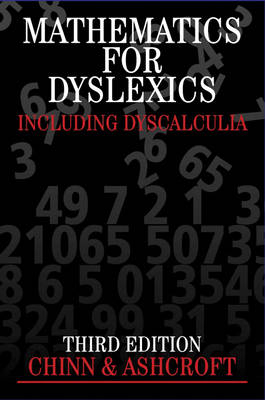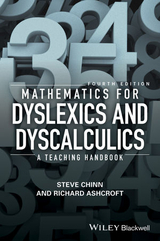
Mathematics for Dyslexics
John Wiley & Sons Ltd (Verlag)
978-0-470-02692-2 (ISBN)
- Titel erscheint in neuer Auflage
- Artikel merken
Mathematics for Dyslexics: Including Dyscalculia, 3rd Edition discusses the factors that contribute to the potential difficulties many dyslexic learners may have with mathematics, and suggests ways of addressing these difficulties. The first chapters consider the theoretical background. The later chapters look at practical methods, which may help dyslexic learners. The book is designed to be comprehensive and to help teachers, support assistants, and parents understand the learner and to learn a range of skills and thus develop confidence and competence in working with dyslexic pupils.
Dr Chinn is an internationally recognised authority on both mathematics and dyslexia. Apart from his general work on dyslexia as exemplified in Mark College, his specific expertise in mathematics is widely known and appreciated.
Foreword to Second Edition. Chapter 1: Dyscalculia, Dyslexia and Mathematics. Introduction. Definitions of Dyslexia. Dyscalculia. The Nature of Mathematics. Chapter 2: Factors that may Contribute to Learning Difficulties in Mathematics. Potential Areas of Difficulty in Learning Mathematics. General Principles of Intervention. Summary. Chapter 3: Cognitive (Thinking) Style in Mathematics Introduction. Qualitative and Quantitative Style. Cognitive (Thinking) Style in the Classroom Grasshoppers (Intuitive/Answer Oriented) and Inchworms (Step by Step/Formula Oriented). Examples. Summary. Chapter 4: Testing and Diagnosis. A Diagnostic Test Protocol. Structure of the Diagnostic Protocol. Attitude and Anxiety. Thinking Style or Cognitive Style. Summary of the Test Protocol. Testing for Dyscalculia. Chapter 5: Concept of Number. Introduction. Early Recognition of Numbers and Their Values. The Language of Mathematics. Early Number Work. Visual Sense of Number. Visual Clues to the Number Concept. Number Bonds. Place Value. Number Bonds for 10. Numbers near 10, 100 or 1000. Summary. Chapter 6: Addition and Subtraction: Basic Facts. Introduction. Strategies for Learning/Remembering the Addition and Subtraction Facts. Summary. Subtraction Facts. Extension. Chapter 7: Times Tables. Introduction. Rote Learning with Audio Recorders and Computers. Learning by Understanding. The Commutative Property. Learning the Table Square. Summary. Chapter 8: Computational Procedures for Addition and Subtraction. Estimation. Addition. Teaching Subtraction as a Separate Exercise. Chapter 9: Multiplication. Introduction. The Special Case of Multiplying by 10 and Powers of 10. Multiplication. Estimation. Extension. Chapter 10: Division. Introduction. Introduction to Division. Estimating. Division by Powers of 10. Division by Multiples of Powers of ten. Conclusion. Chapter 11: Fractions, Decimals and Percentages: An Introduction. Introduction. Fractions. Decimals. Percentages. A Global Model for Percentages, Fractions and Decimals. A Global Exercise with Fractions, Percentages and Decimals. Chapter 12: Operating with Fractions. Introduction. Making Segment Sizes the Same. Comparing Fractions. Combining Fractions. Adding Fractions. Subtracting Fractions. Combined Additions and Subtractions. Multiplying by Fractions. Multiplying Mixed Fractions. Dividing with Fractions. Chapter 13: Decimals. Introduction. Addition and Subtraction. Multiplication and Division by Powers of 10. Division of Decimals. Summary. Chapter 14: Percentages. Introduction. An Image of Percentage. Summary. Chapter 15: Time. What are the Potential Problems with Time? Reading the Time. Time Problems. Summary. Chapter 16: Teaching the Full Curriculum. Introduction. Some General Principles. Teaching the Other Parts of the Curriculum. Combining the Parts of the Curriculum. Summary. Chapter 17: Attacking and Checking Questions. Practice Examples. Preliminary Checks. Attacking Questions. Methods of attacking questions. Checking. Chapter 18: Important Elements of a Teaching Programme. Introduction. Consider the Pupils' Needs. The Structure of the Course. Classroom Management: Making the Lessons Suit the Pupils. Evolving Expectations and Emphases. Internal Assessment. GCSE Examinations. Summary. Appendices. Appendix 1: Books, Journals, Tests and Games. Appendix 2: Teaching Materials. References. Index.
| Erscheint lt. Verlag | 20.10.2006 |
|---|---|
| Zusatzinfo | Illustrations |
| Verlagsort | Chichester |
| Sprache | englisch |
| Maße | 156 x 229 mm |
| Gewicht | 452 g |
| Themenwelt | Mathematik / Informatik ► Mathematik |
| Medizin / Pharmazie ► Gesundheitsfachberufe ► Logopädie | |
| ISBN-10 | 0-470-02692-8 / 0470026928 |
| ISBN-13 | 978-0-470-02692-2 / 9780470026922 |
| Zustand | Neuware |
| Haben Sie eine Frage zum Produkt? |
aus dem Bereich



